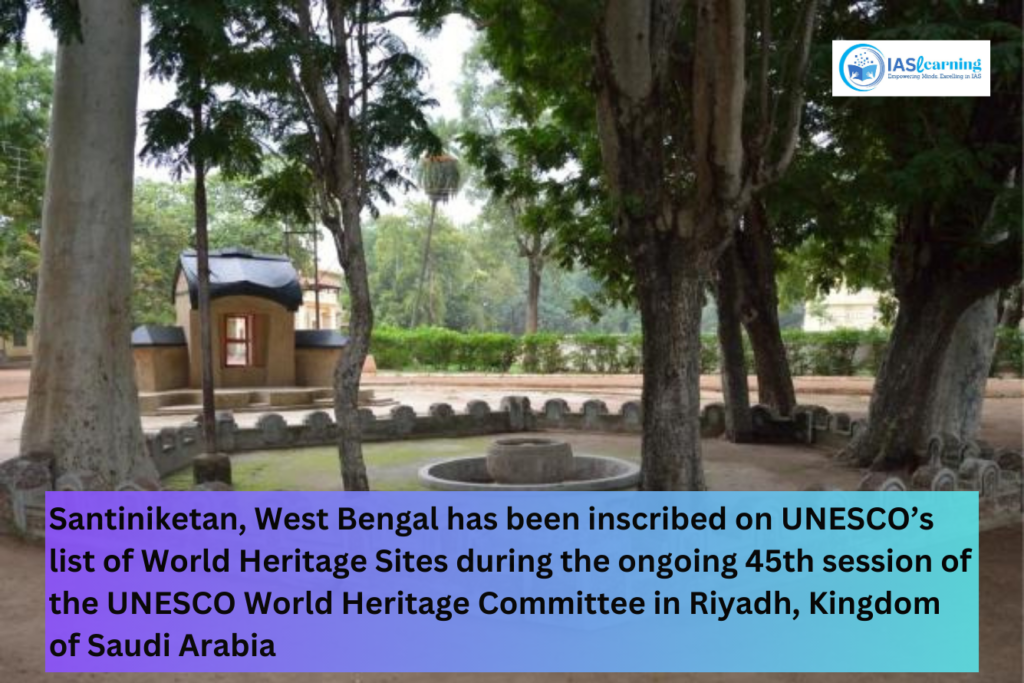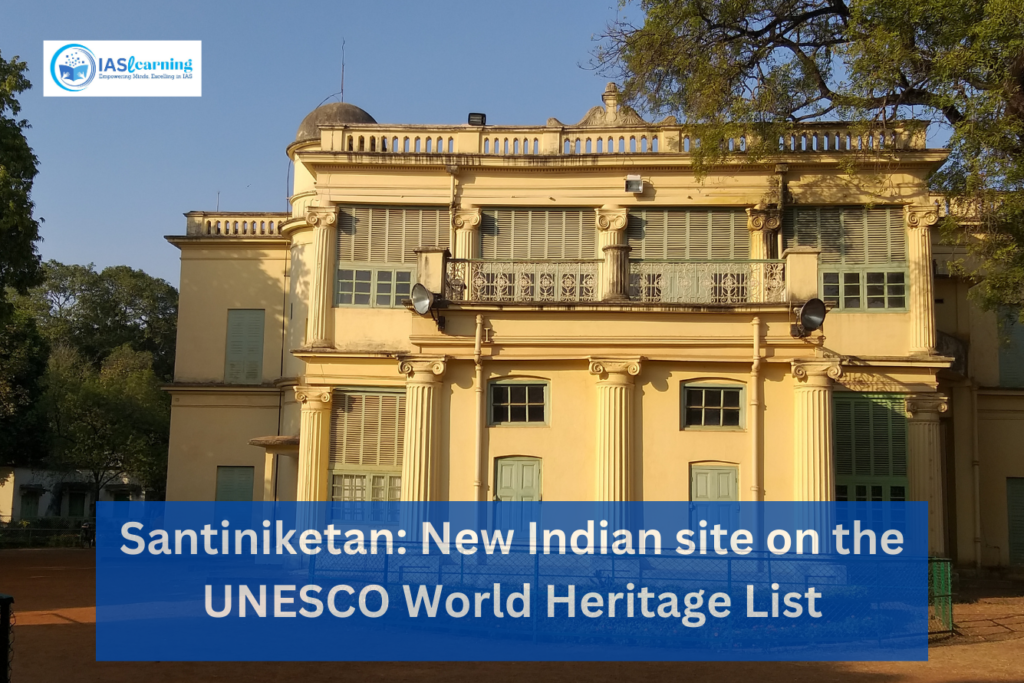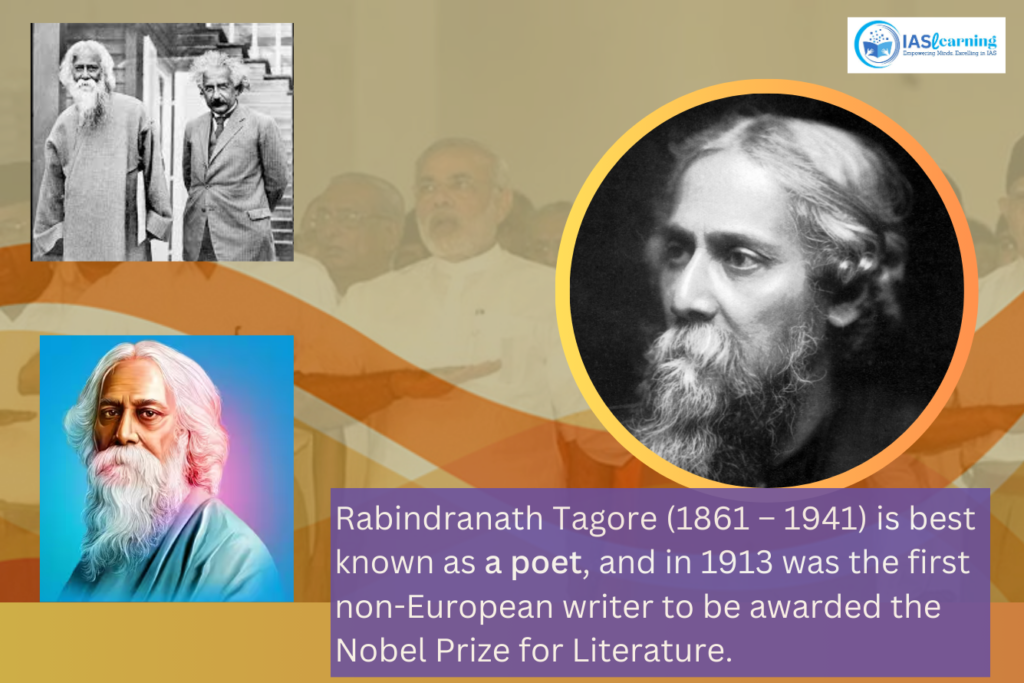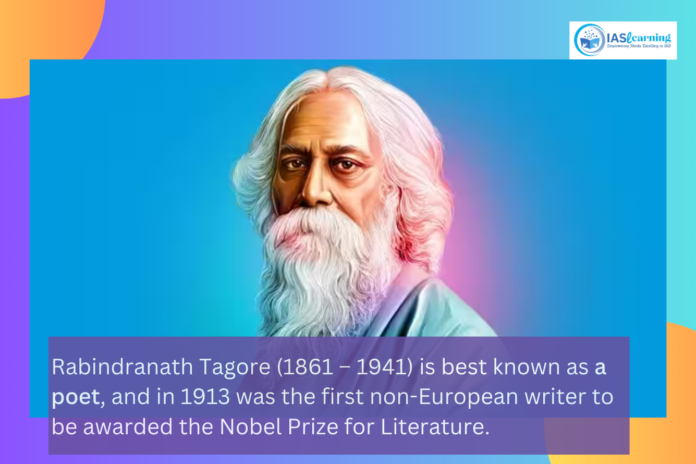SHANTINIKETAN
Context: Shantiniketan has been designated as the 41st UNESCO World Heritage Site (WHS) of India.
- Shantiniketan, with its association with Rabindranath Tagore and other notable figures, has played a significant role in the exchange of human values, art, and ideas.
- Its contributions to architecture, town planning, landscape design, and its association with outstanding cultural and literary works make it a deserving addition to the list of UNESCO World Heritage Sites.
- It is the third UNESCO World Heritage Site in West Bengal, following the Sundarbans National Park and the Darjeeling Himalayan Railway.
- This recognition highlights the rich cultural and natural heritage of the state and its contribution to the world’s cultural and natural diversity.
Shantiniketan, also known as the “Adobe of Peace.” It’s a place of great historical and cultural significance.

- Location: Shantiniketan is located in the Birbhum district of West Bengal, India.
- Description: Shantiniketan is an ensemble of historic buildings, landscapes, gardens, pavilions, artworks, and continuing educational and cultural traditions. It represents a unique brand of internationalism, drawing from various artistic and architectural traditions, including Indian, Japanese, Chinese, Persian, Balinese, Burmese, and Art Deco forms from Western Europe and the United States.
- Uniqueness: Shantiniketan is a unique example of a ‘total work of art’ (Gesamtkunstwerk) where life, learning, work, and art coexist and intertwine. The complex includes 36 historic structures, sculptures, and landscape features. It is a manifestation of humanism, inclusiveness, environmentalism, and a pan-Asian modernism.
- Establishment: Shantiniketan’s history dates back to the middle of the 19th century when Maharshi Devendranath Tagore, the father of Rabindranath Tagore, found solace and serenity in the barren land. He purchased the land and built a house named Santiniketan in 1863, which later became the name for the entire area. The region is flanked on two sides by the rivers, the Ajay and the Kopai.
Shantiniketan’s rich cultural and artistic heritage, along with its natural beauty and educational traditions, make it a significant part of India’s cultural heritage and a well-deserving UNESCO World Heritage Site.
The architectural and cultural features of Santiniketan
The architectural and cultural features of Santiniketan are quite fascinating and reflect a unique blend of indigenous and international influences.

Glass Temple (Mandir): The complex includes the Glass Temple, a non-denominational place of worship, which was one of the first architectural structures in the area.
- Three Main Areas:
- Ashrama (Hermitage): This area likely serves as a place for meditation and solitude.
- Uttaryan: This area includes residential quarters, comprising buildings like Udayan, Konark, Shyamali, Punascha, and Udichi.
- Kala Bhavana and Sangit Bavana: These are schools for art and music, showcasing the educational and cultural importance of Shantiniketan.
- Indigenous Architecture Style: The architecture of Shantiniketan celebrates the narratives of local communities, crafts, and nature. It differs from prevalent architectural styles like Beaux Arts, which were influenced by Roman and Greek classicism, as well as European modernism. Shantiniketan’s architecture is more rooted in its local context.
- Building Materials: The construction materials used in Shantiniketan buildings include both traditional materials like mud and thatch, as well as modern materials like reinforced cement concrete. This reflects a balance between traditional and contemporary building techniques.
- Open Spaces: Open spaces are integral to the complex, and they have been used for cultural exchange and the preservation of Indian art and cultural events through fairs and seasonal festivals. Additionally, informal gatherings (adda) and evening tea parties (Dinanitika Cha Chakra) were part of the engagement and discussion culture in the area.
Santiniketan’s architecture and cultural features embody a unique fusion of local traditions, international influences, and a commitment to promoting the arts, education, and cultural exchange. This makes it a remarkable and significant cultural heritage site.
Rabindranath Tagore (1861-1941):
Rabindranath Tagore was a prominent Indian writer, poet, philosopher, and educator. Here’s a summary of his background and contributions, as well as a comparison with Mahatma Gandhi:
- Birthplace: Kolkata, India.
- Education: He was educated at home and did not complete formal education.
- Profession: Tagore was a versatile individual who excelled in various fields, including writing, song composition, playwriting, essays, and painting.
- Awards: He was awarded the Nobel Prize in Literature in 1913 for his collection of poems titled “Gitanjali.”
- Notable Works: Some of his notable works include “Gitanjali,” “Kabuliwala,” and “Gora.”
Contribution of Rabindranath Tagore in Education:
- Tagore’s educational philosophy emphasized various elements, including self-realization, intellectual development, physical development, moral and spiritual growth, and social development.
- He believed in the co-relation of objects between humans and nature and stressed the importance of economic opportunities.
- Tagore advocated for the use of the mother tongue as the medium of instruction.
Difference Between Mahatma Gandhi and Rabindranath Tagore:

- Education:
- Mahatma Gandhi was critical of Western education and emphasized a return to traditional Indian values.
- Tagore aimed to combine elements of modern Western civilization with the best aspects of Indian tradition.
- Nationalism:
- Gandhi’s concept of nationalism was centered on self-rule involving the whole community, not just the elite.
- Tagore believed that nationalism had a tendency toward individual selfishness raised to a higher level.
- Technology:
- Gandhi opposed the worship of machines and technology, advocating for a more simple and self-reliant lifestyle.
- Tagore, in contrast, emphasized the integration of science and technology in various aspects of life.
Related News: Banglar Mati:
- West Bengal declared Rabindranath Tagore’s “Banglar mati, Banglar jol” as its state anthem.
- The West Bengal Assembly also passed a resolution making Poila Baishakh (the first day of the Bengali calendar, April 15) the statehood day.
- “Banglar Mati” was written during the Banga Bhanga movement against the partition and promotes communal harmony through Raksha Bandhan.
- Tagore was also known for composing “Amar Shonar Bangla” (the national anthem of Bangladesh) and “Vande Mataram” (the national song of India).
Rabindranath Tagore’s contributions to literature, education, and his role in the Indian freedom movement make him an enduring figure in Indian and world history.





SHANTINIKETAN: 41st UNESCO World Heritage Site in India – iaslearning.in
kgqjmeshim http://www.g36v7yny010j9r5te66qje5l0tl360a6s.org/
akgqjmeshim
[url=http://www.g36v7yny010j9r5te66qje5l0tl360a6s.org/]ukgqjmeshim[/url]